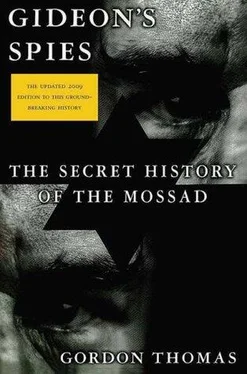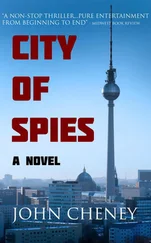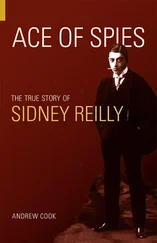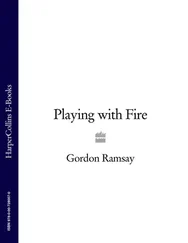Gordon Thomas - Gideon's Spies
Здесь есть возможность читать онлайн «Gordon Thomas - Gideon's Spies» весь текст электронной книги совершенно бесплатно (целиком полную версию без сокращений). В некоторых случаях можно слушать аудио, скачать через торрент в формате fb2 и присутствует краткое содержание. Город: New York, Год выпуска: 2009, ISBN: 2009, Издательство: Thomas Dunne Books, Жанр: История, на английском языке. Описание произведения, (предисловие) а так же отзывы посетителей доступны на портале библиотеки ЛибКат.
- Название:Gideon's Spies
- Автор:
- Издательство:Thomas Dunne Books
- Жанр:
- Год:2009
- Город:New York
- ISBN:978-0-312-53901-6
- Рейтинг книги:4 / 5. Голосов: 1
-
Избранное:Добавить в избранное
- Отзывы:
-
Ваша оценка:
- 80
- 1
- 2
- 3
- 4
- 5
Gideon's Spies: краткое содержание, описание и аннотация
Предлагаем к чтению аннотацию, описание, краткое содержание или предисловие (зависит от того, что написал сам автор книги «Gideon's Spies»). Если вы не нашли необходимую информацию о книге — напишите в комментариях, мы постараемся отыскать её.
Gideon’s Spies
Gideon's Spies — читать онлайн бесплатно полную книгу (весь текст) целиком
Ниже представлен текст книги, разбитый по страницам. Система сохранения места последней прочитанной страницы, позволяет с удобством читать онлайн бесплатно книгу «Gideon's Spies», без необходимости каждый раз заново искать на чём Вы остановились. Поставьте закладку, и сможете в любой момент перейти на страницу, на которой закончили чтение.
Интервал:
Закладка:
Dagan’s chagrin had increased over what he had learned about MI6’s involvement in the critical intelligence that had clinched the case for Prime Minister Tony Blair and President George Bush going to war with Iraq. The intelligence service had produced what it insisted was “conclusive proof” that vast quantities of yellowcake, the iron ore from which enriched uranium is extracted, had been secretly shipped from the impoverished West African country of Niger. The evidence had hinged on documents MI6 insisted it had obtained from “a trusted source.” Dagan knew it would be unthinkable to reveal such a high-value contact, providing that was who he or she was. Apart from MI6, no one else had seen the documents and there was a mounting suspicion they were not all that MI6 claimed. But if nothing else, Meir Dagan had come to the conclusion that the insistence of John Scarlett to continue to defend the veracity of the documents raised questions about his judgment.
The saga of how that happened would turn out to be a classic dirty tricks operation culminating in October 2005 with Lewis Libby, Vice President Dick Cheney’s chief of staff, being indicted on perjury charges and Karl Rove, the White House senior adviser to President Bush, facing investigation by a grand jury. Their role centered in the unmasking of a CIA field officer, Valerie Plame, the wife of a former U.S. ambassador to Niger, Joseph Wilson. It is a criminal offense in America to identify an active secret agent. Mossad’s role in the fiasco would remain untold until these pages.
The story had properly begun in the summer of 2004 with a former employee of SISMI, the Italian equivalent of the CIA. A year before he, “Giancomo” Martino, had resigned from the service to set himself up as an “intelligence analyst.” In no time in Rome, a city well-stocked with journalists and spies, he became a source for, among others, Mossad’s station, which was housed in a building near the Vatican.
In the world of spies and reporters eager for news, Giancomo was a useful contact able to peer through the keyhole of Italy’s security apparatus. The tanned, bespectacled sixty-year-old, with a liking for sand-colored suits and whose English was spoken with an American twang, had from time to time provided snippets of information that, if not exactly earth-shattering, were nevertheless often intriguing. His most recent offering had been photocopies of SISMI documents that showed the agency had been involved in the notorious case of Roberto Calvi (see chapter 20, “God’s Banker… ,” pp. 413–20). The former head of Banco Ambrosiano had close contacts with the Vatican Bank, whose activities were of abiding interest to Mossad. Calvi had been found hanging beneath Blackfriar’s Bridge in London in 1989. The documents Giancomo produced showed three senior SISMI officers had been closely involved with Calvi before his death.
On that summer day in Rome, Giancomo met his Mossad contact, Sammy-O (in the intelligence world aliases are often on a first-name basis, a piece of tradecraft used by most services). But as they sipped drinks in an open-air restaurant, it was not the murky connections between finance and intelligence that Giancomo had to divulge. The seventeen pages he had stored on his laptop came from a time when the CIA and MI6 had been tasked by their political masters to discover evidence that would bolster the claim in Washington that Saddam Hussein had obtained yellowcake ore from Niger. The rock was not only a key material in the process of producing enriched uranium but was also crucial to the Bush/Blair justification for going to war. Sammy-O’s initial study of the documents showed some of them were encrypted, an indication they could be genuine. But there were also spelling mistakes and inconsistencies with dates. Were these the documents George W. Bush and Tony Blair had used to help recruit support for the invasion of Iraq? Giancomo had shrugged, a favourite gesture when he did not wish to commit himself.
Sammy-O had asked Giancomo to explain the spelling mistakes. The informer had again shrugged. Where had the documents originated? Giancomo had replied, according to the agent’s later report submitted to Tel Aviv, that a contact in SISMI had introduced him to a woman official at the Niger Embassy in Rome. After some discussion she had handed the documents over. Sammy-O had the usual questions: Who else had seen them? Why had the woman done that? What deal did Giancomo have with her? Giancomo had refused to answer. The documents indicated the yellowcake ore had been secretly sold to Iraq. They appeared to reinforce the claims of Bush and Blair that they had been right to go to war.
Niger’s yellowcake came from two mines controlled by a French company, who operated within strict international laws governing the export of the ore. One document indicated the ore had come from “unofficial workings” whose product was sold on the black market. It was that market into which Saddam had supposedly tapped. Sammy-O had a final question: How much did Giancomo want for the documents? Fifty thousand Swiss francs was the instant response. The silence that followed was broken by Giancomo.
“The documents are forgeries. They were created by SISMI for the CIA and MI6 to support the claim of Blair and Bush that Saddam Hussein had obtained the ore. Don’t you see what that means?”
Sammy-O saw. The forgeries had been the ones which MI6 had insisted were genuine and which Tony Blair and George Bush had used to defend going to war with Iraq. The documents reinforced the claim of the former ambassador to Niger, Joseph Wilson, who had been sent there by Bush in 2002 to check on their authenticity and had reported back that no yellowcake had gone to Iraq. President Bush had rejected his report and gone to war. When the initial conflict ended, Wilson had finally gone public on his findings and found himself discredited in a campaign orchestrated by Karl Rove and Lewis Libby, which had included them revealing the identity of Wilson’s CIA secret agent wife, Valerie Plame.
What transpired under the café awning between Sammy-O and Giancomo came down to this: Mossad had paid the asking price for the forgeries. For the moment they would be used as a teaching tool at the service’s training school, an example of an operation to seriously embarrass two world leaders. Who had asked SISMI to plant the fake documents would remain unknown, but Mossad knew that in the past the Italian service had bugged the country’s presidential palace and the papal library as a favor to the CIA. And that agency had long fallen out with its Washington masters over the White House deliberately misrepresenting the truth about Saddam’s nonexistent arsenal. Mossad believed Langley had set out to seriously embarrass the Bush administration, who had sidestepped the CIA’s own intelligence-gathering apparatus before the Iraq war and after the conflict had condemned the agency for not providing sufficient intelligence. Using SISMI—and not for the first time—the CIA could expect its complicity to have remained undiscovered. That had happened before in black operations in Latin America. What the CIA had not calculated was Giancomo’s greed for a sale. He knew that Mossad would pay for the documents, whether they were genuine or forgeries, once it realized they were the ones upon which Blair and Bush had largely based their case for going to war. Giancomo’s refusal to say who else had seen them was a strong clue he had sold them to the MI6 station in Rome. All else had flowed from that.
As well as MI6’s continued insistence the forged documents were genuine, there were other claims that concerned Mossad’s view of the way the service was operating under Scarlett. He had claimed another “high-value source” had provided “good evidence” in the run-up to war that Saddam Hussein had portable chemical labs roaming in Iraq deserts ready to launch warheads with chemical and biological agents. The then U.S. secretary of state Colin Powell had endorsed the claim in his eve-of-war address to the United Nations, citing the source as MI6. Later, Mossad’s deep-cover agents had established no mobile labs ever existed.
Читать дальшеИнтервал:
Закладка:
Похожие книги на «Gideon's Spies»
Представляем Вашему вниманию похожие книги на «Gideon's Spies» списком для выбора. Мы отобрали схожую по названию и смыслу литературу в надежде предоставить читателям больше вариантов отыскать новые, интересные, ещё непрочитанные произведения.
Обсуждение, отзывы о книге «Gideon's Spies» и просто собственные мнения читателей. Оставьте ваши комментарии, напишите, что Вы думаете о произведении, его смысле или главных героях. Укажите что конкретно понравилось, а что нет, и почему Вы так считаете.












